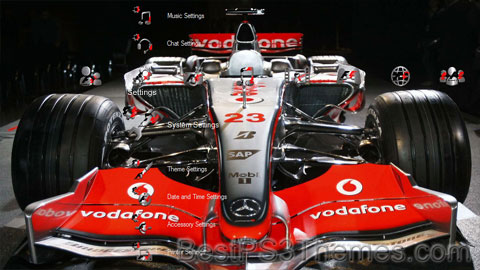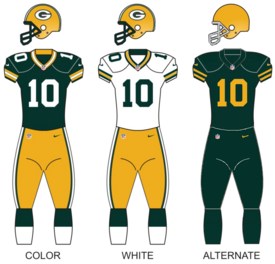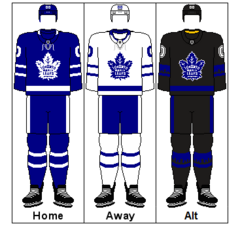Buffalo Sabres theme by Tony
Download: BuffaloSabres.p3t
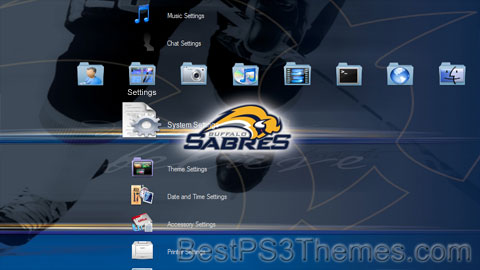
(4 backgrounds)
| Buffalo Sabres | |
|---|---|
 | |
| Conference | Eastern |
| Division | Atlantic |
| Founded | 1970 |
| History | Buffalo Sabres 1970–present |
| Home arena | KeyBank Center |
| City | Buffalo, New York |
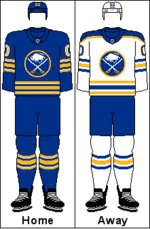 | |
| Team colors | Royal blue, gold, white[1][2][3] |
| Media | MSG Western New York WGR 550 Sabres Hockey Network |
| Owner(s) | Terry Pegula |
| General manager | Kevyn Adams |
| Head coach | Lindy Ruff |
| Captain | Vacant |
| Minor league affiliates | Rochester Americans (AHL) Jacksonville Icemen (ECHL) |
| Stanley Cups | 0 |
| Conference championships | 3 (1974–75, 1979–80, 1998–99) |
| Presidents' Trophy | 1 (2006–07) |
| Division championships | 6 (1974–75, 1979–80, 1980–81, 1996–97, 2006–07, 2009–10) |
| Official website | www |
The Buffalo Sabres are a professional ice hockey team based in Buffalo, New York. The Sabres compete in the National Hockey League (NHL) as a member of the Atlantic Division in the Eastern Conference. The team was established in 1970, along with the Vancouver Canucks, when the league expanded to 14 teams. The Sabres have played their home games at KeyBank Center since 1996, having previously played at the Buffalo Memorial Auditorium since their inception. The Sabres are owned by Terry Pegula, who purchased the club in 2011 from Tom Golisano.
The team has twice advanced to the Stanley Cup Finals, losing to the Philadelphia Flyers in 1975 and to the Dallas Stars in 1999. The Sabres, along with the Canucks, are the oldest active NHL franchises to have never won the Stanley Cup.[4] The Sabres have the longest active playoff drought in the NHL and professional sports, at 13 seasons, which stands as an NHL record.[5]
History[edit]
Early years and the French Connection (1970–1981)[edit]
The Sabres, along with the Vancouver Canucks, joined the NHL in the 1970–71 season. Their first owners were Seymour H. Knox III and Northrup Knox, scions of a family long prominent in Western New York and grandsons of the co-founders of the Woolworth's variety store chain; along with Robert O. Swados, a Buffalo attorney. On the team's inaugural board of directors were Robert E. Rich Jr., later the owner of the Buffalo Bisons minor league baseball team; and George W. Strawbridge Jr., an heir to the Campbell Soup Company fortune. Buffalo had a history of professional hockey; immediately prior to the Sabres' establishment, the Buffalo Bisons were a pillar of the American Hockey League (AHL), having existed since 1940 (and before that, another Bisons hockey team played from 1928 to 1936), winning the Calder Cup in their final season.[6]
Wanting a name other than "bison" (a generic stock name used by Buffalo sports teams for decades), the Knoxes commissioned a name-the-team contest. With names like "Mugwumps", "Buzzing Bees" and "Flying Zeppelins" being entered,[7] the winning choice, "Sabres", was chosen because Seymour Knox felt a sabre was a weapon carried by a leader, and could be effective on both offense and defense.[A][B] The Knoxes tried twice before to get an NHL team, first when the NHL expanded in 1967, and again when they attempted to purchase the Oakland Seals with the intent of moving them to Buffalo. Their first attempt was thwarted when Pittsburgh Steelers owner Art Rooney persuaded his horse racing friends James and Bruce Norris to select Pittsburgh over Buffalo,[9] while the second attempt was due to the NHL not wanting an expansion market to give up on a team so soon, nor isolate the Los Angeles Kings (the only NHL team other than the Seals west of St. Louis at the time) from the rest of the NHL entirely. At the time of their creation, the Sabres exercised their option to create their own AHL farm team, the Cincinnati Swords. Former Toronto Maple Leafs general manager and head coach Punch Imlach was hired in the same capacity with the Sabres.
The year the Sabres debuted (1970) was an important year for major league sports in Buffalo. In addition to the Sabres' debut, the Buffalo Bills officially joined the National Football League, and the National Basketball Association's Buffalo Braves also began to play, sharing Memorial Auditorium with the Sabres. The city of Buffalo went from having no teams in the established major professional sports leagues to three in one off-season, a situation that proved to be unsustainable. Between the Braves and the Sabres, the Sabres would prove to be by far the more successful of the two; Paul Snyder, the nouveau riche Braves owner, publicly feuded with the old money Knoxes and the local college basketball scene, eventually losing those feuds and being forced to sell his team in 1976. Subsequent owners of the Braves, in a series of convoluted transactions tied to the ABA–NBA merger, moved the team out of Buffalo.
When the Sabres debuted as an expansion team, they took the ice to Aram Khachaturian's Armenian war dance, "Sabre Dance".[10] The music has been associated with the team as an unofficial anthem ever since.[11] It is often played between periods and after goals.
The consensus was that the first pick in the 1970 NHL Amateur Draft would be junior phenomenon Gilbert Perreault. Either the Sabres or the Canucks would get the first pick, to be determined with the spin of a wheel of fortune. Perreault was available to the Sabres and Canucks as this was the first year the Montreal Canadiens did not have a priority right to draft Quebec-born junior players.
The Canucks were allocated numbers 1–10 on the wheel, while the Sabres had 11–20. When league president Clarence Campbell spun the wheel, he initially thought the pointer landed on one. While Campbell was congratulating the Vancouver delegation, Imlach asked Campbell to check again. As it turned out, the pointer was on 11, effectively handing Perreault to the Sabres.[12] Perreault scored 38 goals in his rookie season of 1970–71, at the time a record for most goals scored by a NHL rookie, and he received the Calder Memorial Trophy as the NHL's rookie of the year. Despite Perreault's play, the Sabres finished well out of playoff contention.

In the team's second season, 1971–72, rookie Rick Martin, drafted fifth overall by Buffalo in 1971, and Rene Robert, acquired in a late-season trade from the Pittsburgh Penguins, joined Perreault and would become one of the league's top forward lines in the 1970s. Martin broke Perreault's record at once with 44 rookie goals. They were nicknamed "The French Connection" after the movie of the same name and in homage to their French-Canadian roots. The Sabres made the playoffs for the first time in 1972–73, just the team's third year in the league, but lost in the quarterfinals in six games to the eventual Stanley Cup champion Montreal Canadiens.
After a subpar year in 1974 that saw them miss the playoffs (as well as aging defenseman Tim Horton's death in a DUI-induced car accident), the Sabres tied for the best record in the NHL in the 1974–75 regular season. Buffalo advanced to the Stanley Cup Finals for the first time in team history to play against the rough Philadelphia Flyers (who had been recently nicknamed the "Broad Street Bullies"), a series which included the legendary Fog Game (Game 3 of the series). Due to unusual heat in Buffalo in May 1975 and the lack of air conditioning in the Buffalo Memorial Auditorium, parts of the game were played in heavy fog that made players, officials, and the puck invisible to many spectators. During a face-off and through the fog, Sabres center Jim Lorentz spotted a bat flying across the rink, swung at it with his stick, killing it. It was the only time that any player killed an animal during an NHL game. The Sabres won that game thanks to Rene Robert's goal in overtime. However, Philadelphia would wind up taking the Stanley Cup in six games, winning the series 4–2.
The French Connection, joined by 50–goal scorer Danny Gare, continued to score prolifically for the Sabres in 1975–76, but the team lost in the quarterfinals to the New York Islanders. The Sabres had success through the late 1970s behind Gare and the French Connection (Perreault, Martin and Robert), but they were unable to return to the Finals despite a Wales Conference championship in 1980 and being the first team to beat the Soviet Olympic Team when they toured the United States. The French Connection era ended with Robert's trade to the Colorado Rockies in 1979 and Martin's trade to the Los Angeles Kings in 1981, by which time Martin's career was essentially finished as the result of a devastating knee injury in 1980. All three players have had their sweater numbers (11, 7 and 14, respectively) retired and a statue erected in their honor at KeyBank Center in 2012.
Adams/Northeast Division rivalries (1981–1996)[edit]
This section needs additional citations for verification. (March 2019) |
In 1981–82, the NHL realigned its conferences and adopted an intra-divisional playoff format for the first two rounds. It was the beginning of an era in which the Sabres would finish in the middle of the Adams Division standings with regularity, and then face the near-certainty of having to get past either the Boston Bruins or Canadiens to make it to the conference finals. Aside from first-round victories over Montreal in 1982–83 and Boston in 1992–93, the era saw the Sabres lose to division rivals Boston, the Quebec Nordiques and Montreal in the Adams Division semi-finals (first round) a combined eight times, and miss the playoffs altogether in 1985–86 and 1986–87—only third and fourth times out of the playoffs in franchise history. Perrault reached the 500-goal mark in the 1985–86 season and retired after playing 20 games in 1986–87, 17 years after joining the Sabres as their first draft pick.
The Sabres drafted Pierre Turgeon with the first pick in the 1987 NHL Entry Draft, and he quickly made an impact with the team. During his rookie season in 1987–88, he helped the Sabres reach the playoffs for the first time in three years. He was joined in 1989 by Alexander Mogilny, who with the help of Sabres officials became the first Soviet player to defect to the NHL, and cleared the way for all other Russian players to follow. In the 1989–90 season, the Sabres would improve to finish with 98 points—third-best in the NHL—but the playoff futility continued with a first-round loss to Montreal. The Sabres traded Turgeon to the New York Islanders in 1991 as part of a blockbuster seven-player trade that brought Pat LaFontaine to Buffalo.
In 1992–93, goaltender Dominik Hasek joined the team in a trade from the Chicago Blackhawks. In the 1993 playoffs, the Sabres upset the Bruins in a four-game sweep in the Adams Division semi-finals, their first playoff series victory in ten years. Brad May's series-winning goal in overtime of Game 4 in Buffalo was made famous by Rick Jeanneret's "May Day!" call. However, the eventual Stanley Cup champion Montreal Canadiens swept the Sabres in the division final, with the Sabres losing all four games by a 4–3 score (the last three games in overtime).
With the NHL adopting a conference playoff format for the 1993–94 season, the Sabres faced the New Jersey Devils in the Eastern Conference playoffs' first round. Despite Hasek winning a 1–0 (quadruple overtime) goaltending duel with the Devils' Martin Brodeur in Game 6—the Sabres' longest game ever, which went into quadruple overtime—Buffalo would lose the series in seven games. Another first-round playoff loss to the Philadelphia Flyers in the lockout-shortened 1994–95 season was followed by a fifth-place finish in the Northeast Division in 1995–96, as the team missed the playoffs for the first time in nine years. It was the first season under head coach Ted Nolan and the last for the Sabres at Buffalo Memorial Auditorium. Nolan brought an exciting brand of hockey to Buffalo. During his coaching tenure, Buffalo was referred to as the "hardest-working team in hockey".[13] This season also featured the debut of "walk-on" veteran Randy Burridge, who earned a spot on the roster after he attended training camp on a try-out basis. He scored 25 goals that season and was second in team scoring to Pat LaFontaine. Burridge also earned the Tim Horton Award for being the unsung hero and was voted team Most Valuable Player.
The final game in Memorial Auditorium was played on April 14, 1996, a 4–1 victory over the Hartford Whalers. Sabres principal owner Seymour Knox died a month later, on May 22, 1996.
The black and red era (1996–2006)[edit]
Ted Nolan and the Sabres rebounded in 1996–97, their first at Marine Midland Arena, by winning their first division title in 16 years, with Nolan winning the Jack Adams Award as the NHL's top coach, Dominik Hasek winning both the Hart and Vezina Trophies (the first goaltender to do so since Montreal's Jacques Plante in 1962), Michael Peca taking home the Frank J. Selke Trophy as the best defensive forward in the NHL and general manager John Muckler honored as Executive of the Year.
However, the regular season success was overshadowed by what had taken place during the playoffs. Tensions between Nolan and Hasek had been high for most of the season. After being scored upon in Game 3 of the first round against the Ottawa Senators, Hasek left the game, forcing backup Steve Shields to step in. Hasek claimed he felt his knee pop, and the team doctor pronounced him day-to-day. The Buffalo News columnist Jim Kelley wrote a column that night for the next day's newspaper that detailed the day's events, which irked Hasek. After the Senators won Game 5, Hasek came out of the Sabres' training room and attacked Kelley, tearing his shirt. Despite the fact Hasek issued an apology, things went downhill after the incident. Shields starred as the Sabres rallied to win the series against Ottawa. But before the next series against the Philadelphia Flyers, the NHL announced Hasek had been suspended for three games, with the Sabres informing the NHL Hasek was healthy (Hasek most likely would not have been suspended had he not been cleared to play). Set to return in Game 4 with the Sabres down by three games to none, Hasek told the Sabres' coaching staff he felt a twinge in his knee and left the ice after the pre-game skate. Shields turned in another season-saving performance as Buffalo staved off elimination with a win in overtime. Again before Game 5, Hasek declared himself unfit to play and Buffalo lost 6–3 and the series.
Team president Larry Quinn fired general manager John Muckler, who had a noted feud with Nolan. Hasek, who supported Muckler, openly told reporters at the NHL Awards Ceremony he did not respect Nolan, placing new general manager Darcy Regier in a tough position. He offered Nolan just a one-year contract for a reported $500,000. Nolan refused on the grounds his previous contract was for two years. Regier then pulled the contract off the table and did not offer another one, ending Nolan's tenure as Sabres coach. Nolan was offered several jobs from the Tampa Bay Lightning and New York Islanders, which he turned down, and was out of the NHL until June 2006 when he was named coach of the Islanders. Former Sabres captain Lindy Ruff was hired as head coach on July 21, 1997, agreeing to a three-year contract. The Sabres organization, after having their most successful season in nearly two decades, had fired both the reigning NHL Executive of the Year (Muckler) and Coach of the Year (Nolan).
New owners and return to the Finals[edit]
During the 1997–98 season, the Sabres, which had lost $32 million over the previous three seasons and nearly missed payroll in December 1997,[14] were sold by Northrop Knox to John Rigas, owner of Adelphia Communications. Shortly thereafter, Quinn was dismissed and replaced by John Rigas' son, Timothy Rigas. Behind Hasek, left-winger Miroslav Satan (who led the team in scoring), right-winger Donald Audette, center Michael Peca and several role-playing journeymen including Matthew Barnaby, the Sabres reached the Eastern Conference Finals that season, but lost to the Washington Capitals in six games.

In 1998–99, Miroslav Satan scored 40 goals. The Sabres would add centers Stu Barnes from the Pittsburgh Penguins and Joe Juneau from the Capitals. Michal Grosek had the best season of his career, and the team finally returned to the Stanley Cup Finals, this time against the Presidents' Trophy winner, the Dallas Stars. In Game 6, Stars winger Brett Hull's triple-overtime goal ended the series, and the Stars were awarded the Cup. In 1999, it was illegal to score a goal if an offensive player's skate entered the crease before the puck did. However, NHL officials maintained that Hull's two shots in the goal mouth constituted a single possession of the puck since the puck deflected off Hasek. The rule was changed for the following season, allowing players to be inside the goaltender's crease as long as they do not interfere with the goaltender.
The next year was a disappointing season. The team struggled in the regular season, due to injuries to Hasek as well as other tired and discouraged players. Doug Gilmour was acquired from the Chicago Blackhawks at the trade deadline and sparked the Sabres to a playoff berth. However, Gilmour was stricken by stomach flu during the postseason, and even Hasek's return could not prevent a first-round playoff series loss to the Philadelphia Flyers. Like the previous season, there would be an officiating controversy. In Game 2, Flyers left wing John LeClair put the puck in the net through a hole in the mesh. While replays appeared to show the puck entering through the "side" of the net, the goal was allowed to stand. The Flyers would win the game 2–1 and go on to win the series four games to one.
Captain Michael Peca sat out 2000–01 due to a contract dispute, and was later traded to the New York Islanders in June 2001 in exchange for Tim Connolly and Taylor Pyatt. Even so, the Sabres still defeated Philadelphia in six games in the first round of the playoffs (with a resounding 8–0 victory in the series-winning game). In the second round, they faced the underdog Pittsburgh Penguins, led by rejuvenated superstar Mario Lemieux and captain Jaromir Jagr, who had won his fifth Art Ross Trophy that season, losing on a seventh-game overtime goal scored by defenseman Darius Kasparaitis. After lengthy and failed negotiations with their star goaltender, the Sabres traded Hasek to the Detroit Red Wings in the summer of 2001, bringing a five-year era of playoff success to a close. Without Hasek and Peca, the Sabres missed the 2002 playoffs.
Ownership turmoil and lockout[edit]
In May 2002, John Rigas and his sons were indicted for bank, wire and securities fraud for embezzling more than $2 billion from Adelphia. Rigas was later convicted and presently is appealing a sentence of 15 years in prison. The NHL took control of the team, though the Rigas family remained owners on paper. For a while, there were no interested buyers. After the two-year period of uncertainty, including rumors of relocating to another city or even straight out folding, the team was sold to a consortium led by Rochester, New York, billionaire and former New York gubernatorial candidate Tom Golisano and former Sabres president Larry Quinn, whose bid included no government funding. Golisano was introduced as team owner on March 19, 2003.
With the 2002–03 season having started under NHL control, general manager Darcy Regier could make only minimal moves. However, with the consultations of impending new ownership, the team began their rebuilding process around the March 2003 trade deadline by clearing out veteran players. The first to go was winger Rob Ray, who was sent to the Ottawa Senators. The team then sent center and team captain Stu Barnes to the Dallas Stars in exchange for young winger Michael Ryan and a draft pick.
A third deal sent center Chris Gratton to the Phoenix Coyotes with a draft pick for Daniel Briere and a draft pick, adding a player who would play a key role in the Sabres' resurgence in later years. The 2003–04 season saw the team emerge from its financial struggles and, though the Sabres narrowly missed the playoffs, the development of prominent young players. Although the 2004–05 NHL season was canceled due to a labor dispute, the league and the National Hockey League Players' Association (NHLPA) were able to agree on a new collective bargaining agreement in the summer of 2005, thus enabling NHL hockey to return for the 2005–06 season.

On January 19, 2005, the Sabres lost their main cable television broadcaster, as the Empire Sports Network (which had been on the air since 1991) ceased operations in a cost-cutting move during the Adelphia scandal and reorganization. (Like the Sabres, Empire had been owned by Adelphia prior to the NHL's seizure of the franchise.) Adelphia sold their rights to Sabres telecasts and for the 2005–06 campaign Madison Square Garden Network (MSG), a New York City-based channel which broadcasts New York Rangers, New York Islanders and New Jersey Devils games, took over the rights to broadcast Sabres games to television viewers in western New York, with the Sabres controlling all aspects of the broadcast. The agreement was later extended through 2017, then again through 2027.
In 2005–06, the Sabres took off, finishing with their best record in over 20 years and clinching their first playoff berth since the 2000–01 season. The team finished the regular season with 52 wins, surpassing the 50-win mark for the first time in franchise histor
Feyenoord Rotterdam!
Feyenoord Rotterdam! theme by Sjarper
Download: FeyenoordRotterdam.p3t
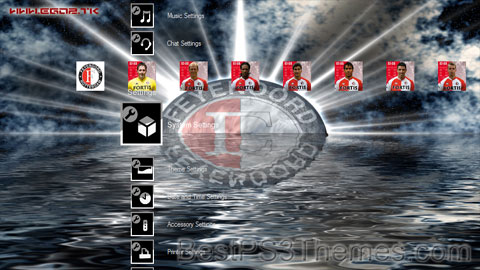
(5 backgrounds)
P3T Unpacker v0.12
Copyright (c) 2007. Anoop Menon
This program unpacks Playstation 3 Theme files (.p3t) so that you can touch-up an existing theme to your likings or use a certain wallpaper from it (as many themes have multiple). But remember, if you use content from another theme and release it, be sure to give credit!
Download for Windows: p3textractor.zip
Instructions:
Download p3textractor.zip from above. Extract the files to a folder with a program such as WinZip or WinRAR. Now there are multiple ways to extract the theme.
The first way is to simply open the p3t file with p3textractor.exe. If you don’t know how to do this, right click the p3t file and select Open With. Alternatively, open the p3t file and it will ask you to select a program to open with. Click Browse and find p3textractor.exe from where you previously extracted it to. It will open CMD and extract the theme to extracted.[filename]. After that, all you need to do for any future p3t files is open them and it will extract.
The second way is very simple. Just drag the p3t file to p3textractor.exe. It will open CMD and extract the theme to extracted.[filename].
For the third way, first put the p3t file you want to extract into the same folder as p3textractor.exe. Open CMD and browse to the folder with p3extractor.exe. Enter the following:
p3textractor filename.p3t [destination path]Replace filename with the name of the p3t file, and replace [destination path] with the name of the folder you want the files to be extracted to. A destination path is not required. By default it will extract to extracted.filename.
England Football Club
England Football Club theme by kornyme
Download: EnglandFC.p3t
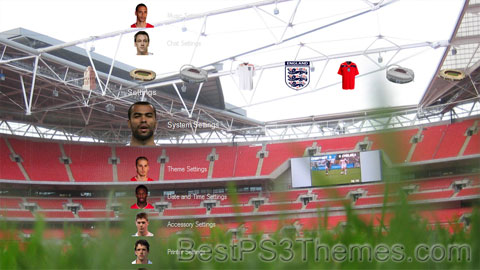
(8 backgrounds)
P3T Unpacker v0.12
Copyright (c) 2007. Anoop Menon
This program unpacks Playstation 3 Theme files (.p3t) so that you can touch-up an existing theme to your likings or use a certain wallpaper from it (as many themes have multiple). But remember, if you use content from another theme and release it, be sure to give credit!
Download for Windows: p3textractor.zip
Instructions:
Download p3textractor.zip from above. Extract the files to a folder with a program such as WinZip or WinRAR. Now there are multiple ways to extract the theme.
The first way is to simply open the p3t file with p3textractor.exe. If you don’t know how to do this, right click the p3t file and select Open With. Alternatively, open the p3t file and it will ask you to select a program to open with. Click Browse and find p3textractor.exe from where you previously extracted it to. It will open CMD and extract the theme to extracted.[filename]. After that, all you need to do for any future p3t files is open them and it will extract.
The second way is very simple. Just drag the p3t file to p3textractor.exe. It will open CMD and extract the theme to extracted.[filename].
For the third way, first put the p3t file you want to extract into the same folder as p3textractor.exe. Open CMD and browse to the folder with p3extractor.exe. Enter the following:
p3textractor filename.p3t [destination path]Replace filename with the name of the p3t file, and replace [destination path] with the name of the folder you want the files to be extracted to. A destination path is not required. By default it will extract to extracted.filename.
Pro Evolution Soccer 2008 #3
Pro Evolution Soccer 2008 theme by Jack Revill
Download: PES2008_3.p3t
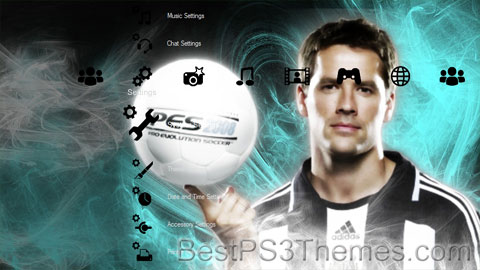
(1 background)
| Pro Evolution Soccer 2008[2] | |
|---|---|
 | |
| Developer(s) | Konami |
| Publisher(s) | Konami |
| Series | Pro Evolution Soccer |
| Platform(s) | |
| Release | Nintendo DS PlayStation 2, PlayStation 3 & Xbox 360 Windows PlayStation Portable Wii Mobile
|
| Genre(s) | Sports game |
| Mode(s) | Single-player, multiplayer |
Pro Evolution Soccer 2008[2] (PES 2008), known as World Soccer: Winning Eleven 2008 in Asia and sometimes called World Soccer: Winning Eleven 11 (PS2) in North America, is an association football video game in the Pro Evolution Soccer series by Konami. The game was announced on 18 June 2007. Its title is different from the other Pro Evolution Soccer games in that it is of a year and not a version; this was due to EA Sports' FIFA series naming their titles with two digit numbers (i.e. 07, 08), which would seem that PES was a year behind FIFA (to non-fans which had no knowledge of the previous games of the franchise). It was released for Windows, Wii, Nintendo DS, PlayStation 3, PlayStation 2, PlayStation Portable, Xbox 360 And mobile. The game sold 6.37 million units worldwide. PES 2008 was succeeded by Pro Evolution Soccer 2009. This was the first game of the series to be released for the PS3 and Wii, as well as the first game in the series to be internationally available on a Nintendo home console.
Wii version[edit]
The Nintendo Wii version of PES 2008 (named Winning Eleven Play Maker 2008 in Japan) differs radically from the other versions. The basic gameplay is centered around pointing the Wii Remote at the screen and directing players by dragging them with the on-screen cursor, and passing is done by simply pointing to the desired space or player and pressing a button. This allows for a more tactical approach to the game, as there is almost complete freedom in moving any player on the screen anywhere, and much more tactics and maneuvers can be used in the attacking game than ever before.
This version omits the Master League mode for the Champions Road, which lets the player tour a slew of different leagues around Europe, and when a games is won, it is possible to acquire players from the defeated teams. Also, it features an online mode that Konami called "the best online experience" when compared to the other versions.[3]
Teams[edit]
Unlicensed leagues[edit]
The leagues below are partially unlicensed, and some teams from these leagues are unlicensed:
Licensed leagues[edit]
The leagues below are fully licensed, and all teams from these leagues are licensed:
Generic Teams[edit]
There is also a separate league with 18 generic teams (Team A, Team B etc.), which can be edited fully, like in the previous game. This is thought to be due to the fact that Konami failed to get the rights to the German Bundesliga, and is usually made into the Bundesliga or another league of one's preference by patch makers. However, most people use this to put their edited players into playable teams from the start instead of having to play through Master League to purchase them or alternatively edit the existing non-generic teams. This feature does not appear in the Wii version of the game.
Covers[edit]
Portugal and (at the time) Manchester United player Cristiano Ronaldo is included on all PES 2008 covers, along with Newcastle United striker Michael Owen in the UK, Juventus goalkeeper Gianluigi Buffon in Italy, West Ham United defender Lucas Neill in Australia, and Chelsea F.C. striker Didier Drogba in France.[4] Also in Japanese version, the cover art only Cristiano Ronaldo himself.
Commentators[edit]
Jon Champion and Mark Lawrenson provide the English commentary for the first time, replacing long-time commentary team Peter Brackley and Trevor Brooking, who commentated from Pro Evolution Soccers 2 to 6.[5] Also in the Japanese version, Jon Kabira and Tsuyoshi Kitazawa continue as commentators among Masahiro Fukuda and the pitch reporter was Florent Dabadie.
Reception[edit]
| Aggregator | Score | ||||||
|---|---|---|---|---|---|---|---|
| DS | PC | PS2 | PS3 | PSP | Wii | Xbox 360 | |
| GameRankings | 58.57%[42] | 78.50%[43] | 82.58%[44] | 73.46%[45] | 79.74%[46] | 83.60%[48] | 75.53%[47] |
| Metacritic | 58/100[49] | N/A | 82/100[50] | 74/100[51] | 80/100[52] | 83/100[54] | 76/100[53] |
| Publication | Score | ||||||
|---|---|---|---|---|---|---|---|
| DS | PC | PS2 | PS3 | PSP | Wii | Xbox 360 | |
| 1Up.com | N/A | N/A | N/A | C+[6] | N/A | B[7] | N/A |
| Eurogamer | 6/10[8] | N/A | N/A | 8/10[9] | 7/10[10] | 8/10[11] | N/A |
| Game Informer | N/A | N/A | N/A | 7.75/10[12] | N/A | 8/10[13] | 7.75/10[12] |
| GameSpot | 6/10[14] | 7/10[15] | 7.5/10[16] | 6/10[17] | 7/10[18] | 8/10[20] | 7/10[19] |
| GameSpy | N/A | N/A | N/A | ||||
| IGN | (US) 5.5/10[25] (UK) 4.7/10[26] | N/A | 8.4/10[27] | (UK) 9.2/10[28] (US) 8.6/10[29] | (UK) 8.9/10[30] (US) 8.3/10[31] | (UK) 8.9/10[34] (US) 8.6/10[35] | (UK) 9.2/10[32] 8.6/10[33][29] |
| Official Nintendo Magazine | N/A | N/A | N/A | N/A | N/A | 90%[36] | N/A |
| Official Xbox Magazine (US) | N/A | N/A | N/A | N/A | N/A | N/A | 4.5/10[37] |
| PC Gamer (UK) | N/A | 86%[38] | N/A | N/A | N/A | N/A | N/A |
| PC PowerPlay | N/A | 6/10[55] | N/A | N/A | N/A | N/A | N/A |
| PlayStation: The Official Magazine | N/A | N/A | N/A | N/A | N/A | N/A | |
| Digital Spy | N/A | N/A | N/A | N/A | N/A | ||
The game sold 6.37 million units worldwide in 2007. Its sales were very close to rival FIFA 2008, which sold 6.55 million units in 2007.[56]
The PlayStation 2 and Xbox 360 releases of Pro Evolution Soccer 2008 each received a "Platinum" sales award from the Entertainment and Leisure Software Publishers Association (ELSPA),[57] indicating sales of at least 300,000 copies per version in the United Kingdom.[58] Pro Evolution Soccer 2008 sold approximately 104,654 copies since its debut in Japan.[59] It debuted at #5 in the UK game charts before moving to #3 in the second week after a 34% increase in sales.[60]
The game was met with positive to mixed reception. GameRankings and Metacritic gave it a score of 83.60% and 83 out of 100 for the Wii version;[48][54] 82.58% and 82 out of 100 for the PlayStation 2 version;[44][50] 79.74% and 80 out of 100 for the PSP version;[46][52] 78.50% for the PC version;[43] 75.53% and 76 out of 100 for the Xbox 360 version;[47][53] 73.46% and 74 out of 100 for the PlayStation 3 version;[45][51] and 58.57% and 58 out of 100 for the DS version.[42][49]
It was awarded Best Sports Game for the Wii by IGN in its 2008 video game awards.[61] It was also nominated for Wii Game of the Year by IGN.[62]
References[edit]
- ^ "Pro Evolution Soccer 2008 Release Information for PlayStation 3". GameFAQs. Archived from the original on September 24, 2015. Retrieved April 9, 2015.
- ^ a b Gibbon, David (June 19, 2007). "'Pro Evolution Soccer 2008' revealed". Digital Spy. Archived from the original on April 14, 2015. Retrieved April 9, 2015.
- ^
F-1
Ottawa Senators
Ottawa Senators theme by Andre Robert
Download: OttawaSenators.p3t
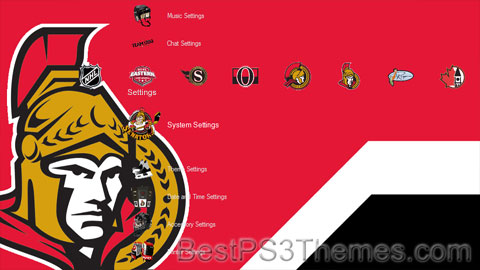
(3 backgrounds)
Ottawa Senators
Sénateurs d'Ottawa 2024–25 Ottawa Senators season
2024–25 Ottawa Senators season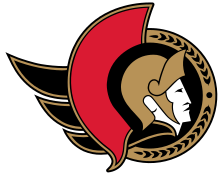
Conference Eastern Division Atlantic Founded December 6, 1990 (began play in 1992) History Ottawa Senators
1992–presentHome arena Canadian Tire Centre City Ottawa, Ontario Team colours Red, black, white, gold[1][2][3]
Media - English
- French
Owner(s) Michael Andlauer General manager Steve Staios Head coach Travis Green Captain Brady Tkachuk Minor league affiliates Stanley Cups 0[a] Conference championships 1 (2006–07) Presidents' Trophy 1 (2002–03) Division championships 4 (1998–99, 2000–01, 2002–03, 2005–06) Official website nhl .com /senators The Ottawa Senators (French: Sénateurs d'Ottawa), officially the Ottawa Senators Hockey Club[b] and colloquially known as the Sens, are a professional ice hockey team based in Ottawa. The Senators compete in the National Hockey League (NHL) as a member of the Atlantic Division in the Eastern Conference and play their home games at the 18,652-seat[5] Canadian Tire Centre, which opened in 1996 as the Palladium.
Founded and established by Ottawa real estate developer Bruce Firestone, the team is the second NHL franchise to use the Ottawa Senators name. The original Ottawa Senators, founded in 1883, had a famed history, winning the Stanley Cup 11 times,[6] playing in the NHL from 1917 until 1934. On December 6, 1990, after a two-year public campaign by Firestone, the NHL awarded a new franchise, which began play in the 1992–93 season.[7] The Senators have made 16 playoff appearances, won four division titles, and won the 2003 Presidents' Trophy. They made an appearance in the 2007 Stanley Cup Finals but lost to the Anaheim Ducks in five games.
History[edit]
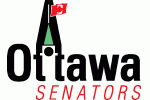
Pre-launch logo used in the "Bring Back the Senators" campaign Ottawa had been home to the original Senators, a founding NHL franchise and 11-time Stanley Cup champions. After the NHL expanded to the United States in the late 1920s, the original Senators' eventual financial losses forced the franchise to move to St. Louis in 1934 operating as the Eagles while a Senators senior amateur team took over the Senators' place in Ottawa.[8] The NHL team was unsuccessful in St. Louis and planned to return to Ottawa, but the NHL decided instead to suspend the franchise and transfer the players to other NHL teams.[9]
Fifty-four years later, after the NHL announced plans to expand, Ottawa real estate developer Bruce Firestone decided along with colleagues Cyril Leeder and Randy Sexton that Ottawa was now able to support an NHL franchise, and the group proceeded to put a bid together. His firm, Terrace Investments, did not have the liquid assets to finance the expansion fee and the team, but the group conceived a strategy to leverage land development. In 1989, after finding a suitable site on farmland just west of Ottawa in Kanata on which to construct a new arena, Terrace announced its intention to win a franchise and launched a successful "Bring Back the Senators" campaign to both woo the public and persuade the NHL that the city could support an NHL franchise. Public support was high, and the group would secure over 11,000 season ticket pledges.[10] On December 12, 1990, the NHL approved a new franchise for Firestone's group to start play in the 1992–93 season.[7]
Early years (1992–1996)[edit]
The new team hired former NHL player Mel Bridgman, who had no previous NHL management experience, as its first general manager in 1992.[11] Ottawa signed former Boston head coach Rick Bowness. The new Senators were placed in the Adams Division of the Wales Conference and played their first game on October 8, 1992, in the Ottawa Civic Centre against the Montreal Canadiens with much pre-game spectacle.[12] The Senators defeated the Canadiens 5–3 in one of the few highlights that season. Following the initial excitement of the opening night victory, the club floundered badly. Eventually, it tied the San Jose Sharks for the worst record in the league, winning only 10 games with 70 losses and four ties for 24 points, three points better than the NHL record for futility.[13] The Senators had aimed low and considered the 1992–93 season a small success, as Firestone had set a goal for the season of not setting a new NHL record for fewest points in a season.[14] The long-term plan was to finish low in the standings for its first few years to secure high draft picks and eventually contend for the Stanley Cup.[14]
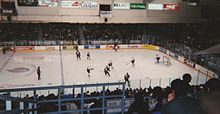
The Senators played their home games at the Ottawa Civic Centre from 1992 to 1996. Terrace needed a partner to make the final franchise payment to the NHL. Firestone sold 50% of Terrace to Rod Bryden, a technology executive and entrepreneur. A limited partnership was set up to own the hockey team and a new company, Palladium Corp., which was charged with building the new arena. The partnership included local high-tech executives and singer Paul Anka, who was born in Ottawa.[15] Bryden would become the sole owner of Terrace and majority owner of the Senators in August 1993, buying out Firestone.[16]
Bridgman was fired after one season and team president Randy Sexton took over the general manager duties. The strategy of aiming low and securing a high draft position did not change. The Senators finished last overall for the next three seasons. For the 1993–94 season, the team now played in the Eastern Conference's Northeast Division. Although 1993 first overall draft choice Alexandre Daigle wound up being one of the greatest draft busts in NHL history, they chose Radek Bonk in 1994, Bryan Berard (traded for Wade Redden) in 1995, Chris Phillips in 1996 and Marian Hossa in 1997, all of whom would become solid NHL players and formed a strong core of players in years to come. Alexei Yashin, the team's first-ever draft selection from 1992, emerged as one of the NHL's brightest young stars. The team traded many of their better veteran players of the era, including 1992–93 leading scorer Norm Maciver and fan favourites Mike Peluso and Bob Kudelski in an effort to stockpile prospects and draft picks.[17][18][19]
As the 1995–96 season began, star centre Alexei Yashin refused to honour his contract and did not play. In December, after three straight last-place finishes and a team which was ridiculed throughout the league, fans began to grow restless waiting for the team's long-term plan to yield results, and arena attendance began to decline. Rick Bowness was fired in late 1995 and was replaced by the Prince Edward Island Senators' head coach Dave Allison. Allison would fare no better than his predecessor, and the team would stumble to a 2–22–3 record under him. Sexton himself was fired and replaced by Pierre Gauthier, the former assistant GM of the Mighty Ducks of Anaheim team.[20] Before the end of January 1996, Gauthier had resolved the team's most pressing issues by settling star player Alexei Yashin's contract dispute, and hiring the highly regarded Jacques Martin as head coach.[21] While Ottawa finished last-overall once again, the season ended with renewed optimism, due in part to the upgraded management and coaching, and also to the emergence of an unheralded rookie from Sweden named Daniel Alfredsson, who would win the Calder Memorial Trophy as NHL Rookie of the Year in 1996.[22]
Jacques Martin era (1996–2004)[edit]
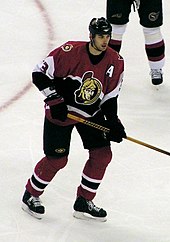
During the 2001 NHL Entry Draft, the Senators acquired Zdeno Chara in a multi-player trade with the New York Islanders. Martin would impose a "strong defence first" philosophy that led to the team qualifying for the playoffs every season that he coached, but he was criticized for the team's lack of success in the playoffs, notably losing four straight series against the provincial rival Toronto Maple Leafs.[23]
In 1996–97, his first season, the club qualified for the playoffs in the last game of the season and nearly defeated the Buffalo Sabres in the first round. In 1997–98, the club finished with their first winning record and upset the heavily favoured New Jersey Devils to win their first playoff series. However, they were ousted in the second round by the Sabres again. [22] In 1998–99, the Senators jumped from fourteenth overall in the previous season to third, with 103 points—the first 100-point season in club history, only to be swept in the first round by the Sabres. In 1999–2000, despite the holdout of team captain Alexei Yashin, Martin guided the team to the playoffs, only to lose to the Maple Leafs in the first Battle of Ontario series.[24][25] Yashin returned for 2000–01 and the team improved to win their division and place second in the Eastern Conference. Yashin played poorly in another first-round playoff loss[26] and on the day of the 2001 NHL Entry Draft, he was traded to the New York Islanders in exchange for Zdeno Chara, Bill Muckalt and the second overall selection in the draft, which Ottawa used to select centre Jason Spezza.[27]
The 2001–02 Senators regular season points total dropped, but in the playoffs, they upset the Philadelphia Flyers for the franchise's second playoff series win. The Sens would go on to push their second-round series to seven games, but they were ultimately once again defeated by the Maple Leafs. Despite speculation that Martin would be fired, it was GM Marshall Johnston who left, retiring from the team.[28] He was replaced by John Muckler, the Senators' first with previous management experience.[29]
Although the Senators were bankrupt, they continued to play in the 2002–03 season after getting emergency financing.[30] Despite the off-ice problems, Ottawa had an outstanding season, placing first overall in the NHL to win the Presidents' Trophy. In the playoffs, they came within one game of making it into the Stanley Cup Finals, losing to the eventual Stanley Cup champion New Jersey Devils.[31] In 2003–04, Martin would guide the team to another good regular season but again would lose in the first round of the playoffs to the Maple Leafs, leading to Martin's dismissal as management felt that a new coach was required for playoff success.[32]
Bankruptcy and sale to Eugene Melnyk[edit]
In 2000, owner Bryden publicly appealed for tax relief from the Government of Canada for all Canadian NHL teams, coping with a significant drop in the Canadian dollar. His appeal was first met with a plan for tax relief, but the tax relief program was cancelled.[33] Bryden then announced the sale of the club outright to a limited partnership in 2002 for CA$186 million, which would include creditors and Bryden himself.[33] After its principal creditor Ogden Entertainment failed, the Senators entered bankruptcy protection in January 2003, owing CA$160 million for the club and CA$210 million for the arena.[34] The deal fell through in 2003 when American investor Nelson Peltz declined to get involved.[35]
In August 2003, pharmaceutical billionaire Eugene Melnyk purchased the club for a reported CA$130 million.[36][37] Melnyk, principal shareholder of Biovail Pharmaceuticals, chose to finance half of the purchase price for the club and arena with debt. Share values of Biovail were depressed, and he did not want to sell them at the lower price.[38]
Bryan Murray era (2004–2016)[edit]
After the playoff loss, owner Melnyk promised that changes were coming, and they came quickly. In June 2004, Anaheim Ducks GM Bryan Murray of nearby Shawville became the head coach. That summer, the team also made substantial personnel changes, trading long-time players Patrick Lalime[39] and Radek Bonk,[40] and signing free agent goaltender Dominik Hasek.[41] The team would not be able to show its new line-up for a year, as the 2004–05 NHL lock-out intervened and most players played in Europe or in the minors. In a final change, just before the 2005–06 season, the team traded long-time player Marian Hossa for Dany Heatley.[42]

Daniel Alfredsson played together with Jason Spezza and Dany Heatley, forming the CASH line. They led the Senators to their first Finals appearance. The media predicted the Senators to be Stanley Cup contenders in 2005–06, as they had a strong core of players returning. They played an up-tempo style that fit the new rule changes, and Hasek was expected to provide top-notch goaltending.[43] The team rushed out of the gate, winning 19 of the first 22 games, in the end winning 52 games and 113 points, placing first in the conference, and second overall. The newly formed 'CASH' line[44] of Alfredsson, Spezza and newly acquired Dany Heatley established itself as one of the league's top offensive lines.[45] Hasek played well until he was injured during the 2006 Winter Olympics,[46] forcing the team to enter the playoffs with rookie netminder Ray Emery as their starter.[47] Without Hasek, the club bowed out in a second-round loss to the Buffalo Sabres.[48]
In 2006–07, the Senators reached the Stanley Cup Finals after qualifying for the playoffs in nine consecutive seasons. The Senators had a high turn-over of personnel and the disappointment of 2006 to overcome and started the season poorly. Trade rumours swirled around Daniel Alfredsson for most of the last months of 2006. The team lifted itself out of last place in the division to nearly catch the Buffalo Sabres by season's end, placing fourth in the Eastern Conference. The team finished with 105 points, their fourth consecutive 100-point season and sixth in the last eight. In the playoffs, Ottawa continued its good play. Led by the 'CASH' line, goaltender Ray Emery, and the strong defence of Chris Phillips and Anton Volchenkov, the club defeated the Pittsburgh Penguins, the second-ranked New Jersey Devils and the top-ranked Sabres to advance to the Stanley Cup Finals.[49]
The 2006–07 Senators thus became the first Ottawa team to be in a Stanley Cup Finals since 1927, and the city was swept up in the excitement.[50] Businesses along all of the main streets posted large hand-drawn "Go Sens Go" signs, residents put up large displays in front of their homes or decorated their cars.[51] A large Ottawa Senators flag was draped on the City Hall, along with a large video screen showing the games. A six-storey likeness of Daniel Alfredsson was hung on the Corel building.[52] Rallies were held outside of City Hall, car rallies of decorated cars paraded through town and a section of downtown, dubbed the "Sens Mile", was closed off to traffic during and after games for fans to congregate.[53]
In the Final, the Senators faced the Anaheim Ducks, considered a favourite since the start of the season, a team the Senators had last played in 2006, and a team known for its strong defence. The Ducks won the first two games in Anaheim 3–2 and 1–0. Returning home, the Senators won game three 5–3 but lost game four 3–2. The Ducks won game five 6–2 in Anaheim to clinch the series and their first Stanley Cup championship. The Ducks had played outstanding defence, shutting down the 'CASH' line, forcing Murray to split up the line. The Ducks scored timely goals and Ducks' goaltender Jean-Sebastien Giguere out-played Emery.[54]
In the off-season after the Stanley Cup Finals, Bryan Murray's contract was expiring. At the same time, general manager (GM) John Muckler had one season remaining and was expected to retire. Murray, who had previously been a GM for other NHL clubs, was expected to take over the GM position, although no public timetable was given. Owner Melnyk decided to offer Muckler another position in the organization and give the GM position to Murray. Muckler declined the offer and was relieved from his position.[55] Melnyk publicly justified the move, saying that he expected to lose Murray if his contract ran out.[55] Murray then elevated John Paddock, the assistant coach, to head coach of the Senators.[56] Under Paddock, the team came out to a record start to the 2007–08 season. However, team play declined to a .500 level, and the team was falling out of the playoffs. Paddock was fired by Murray, who took over coaching on an interim basis.[57] The club managed to qualify for the playoffs by a tie-breaker but was swept in the first round of the playoffs by the Pittsburgh Penguins. In June, the club bought out goaltender Ray Emery, who had become notorious for off-ice events in Ottawa and lateness to several team practices.[58]

Martin Gerber was a goaltender for the Senators from 2006 to 2009. For 2008–09, Murray hired Craig Hartsburg to coach the Senators. Under Hartsburg's style, the Senators struggled and played under .500. Uneven goaltending with Martin Gerber and Alex Auld meant the team played cautiously to protect the goaltender. Murray's patience ran out in February 2009, with the team well out of playoff contention, and Hartsburg was fired, although he had two years left on his contract, and the team also had Paddock under contract.[59] Cory Clouston was elevated from the Binghamton coaching position.[59] The team played above .500 under Clouston and rookie goaltender Brian Elliott, who had been promoted from Binghamton. Gerber was waived from the team at the trading deadline, and the team traded for goaltender Pascal Leclaire, although he would not play due to injury. The team failed to make the playoffs for the first time in 12 seasons. Auld would be traded in the off-season to make room. Clouston's coaching had caused a rift with top player Dany Heatley (although unspecified "personal issues" were also noted by Heatley), and after Clouston was given a contract to continue coaching, Heatley made a trade demand and was traded just before the start of the 2009–10 season.[60]
In 2009–10, the Senators were a .500 team until going on a team-record 11-game winning streak in January. The streak propelled the team to the top of the Northeast Division standings and a top-three placing for the playoffs. The team could not hold off the Sabres for the division lead but qualified for the playoffs in the fifth position. For the third season in four, the Senators played off against the Pittsburgh Penguins in the first round. A highlight for the Senators was winning a triple-overtime fifth game in Pittsburgh,[61] but the team could not win a playoff game on home ice, losing the series in six games.[62]
The Senators had a much poorer than expected 2010–11 campaign, resulting in constant rumours of a shakeup right through until December. The rumours were heightened in January after the team went on a lengthy losing streak. January was a dismal month for the Senators, winning only one game. Media speculated on the imminent firing of Clouston, Murray or both. Owner Melynk cleared the air in an article in the January 22, 2011 edition of the Ottawa Sun. Melnyk stated that he would not fire either Clouston or Murray but that he had given up on this season and was in the process of developing a plan for the future.[63] On Monday, January 24, The Globe and Mail reported that the plan included hiring a new general manager before the June entry draft and that Murray would be retained as an advisor to the team. A decision on whether to retain Clouston would be made by the new general manager. The article by Roy MacGregor, a long-time reporter of the Ottawa Senators, stated that former assistant coach Pierre McGuire had already been interviewed.[64] Murray, in a press conference that day, stated that he wished to stay on as the team's general manager. He also stated that Melnyk was allowing him to continue as the general manager without restraint. Murray said that the players were now to be judged by their play until the February 28 trade deadline. Murray would attempt to move "a couple, at least," of the players for draft picks or prospects at that time if the Senators remained out of playoff contention.[65]
During the 2010–11 season, the Senators acquired Craig Anderson after swapping goaltenders with the Colorado Avalanche. True to his word, Murray made a flurry of trades. He started his overhaul with the trading of Mike Fisher to the Nashville Predators. Fisher already had a home in Nashville with his wife Carrie Underwood. The trading of Fisher, a fan favourite in Ottawa, led to a small anti-Underwood backlash with the banning of her songs from the playlists of some local radio stations.[66] Murray next traded veterans Chris Kelly,[67] and Jarkko Ruutu.[68] A swap of goaltenders was made with the Colorado Avalanche which brought Craig Anderson to Ottawa in exchange for Brian Elliott, both goaltenders having sub-par years.[69] Next, under-achieving forward Alex Kovalev was traded to the Pittsburgh Penguins.[70] On trade deadline day, Ottawa picked up goaltender Curtis McElhinney on waivers. It traded Chris Campoli with a seventh-round pick to the Chicago Blackhawks for a second-round pick and Ryan Potulny.[71] Goaltender Anderson played very well down the stretch for Ottawa, and the team quickly signed the soon-to-be unrestricted free agent to a four-year contract.[72] After media speculation on the future of Murray within the organization, Murray was re-signed as general manager on April 8 to a three-year extension.[73] On April 9, head coach Cory Clouston and assistants Greg Carvel and Brad Lauer were dismissed from their positions.[74] Murray said that the decision was made based on the fact that the team entered the season believing it was a contender, but finished with a 32–40–10 record.[74] Former Detroit Red Wings' assistant coach Paul MacLean was hired as Clouston's replacement on June 14, 2011.[75]
As the 2011–12 season began, many hockey writers and commentators were convinced that the Senators would finish at or near the bottom of the NHL standings.[76] While rebuilding, the Ottawa line-up contained many rookies and inexperienced players. The team struggled out of the gate, losing five of their first six games before a reversal of fortunes saw them win six games in a row. In December 2011, the team acquired forward Kyle Turris from the Phoenix Coyotes in exchange for highly regarded prospect David Rundblad and a draft pick.[77] The team improved its play afterwards and moved into a playoff position before the All-Star Game. For the first time in Senators' history, the All-Star Game was held in Ottawa and considered a great success. Five Senators were voted in or named to the event, including Daniel Alfredsson, who was named the captain of one team.[78] The team continued its playoff push after the break. After starting goaltender Craig Anderson injured his hand in a kitchen accident at home, the Senators called up Robin Lehner from Binghamton and acquired highly regarded goaltender Ben Bishop from the St. Louis Blues.[79] While Anderson recovered, the team continued its solid play and finished as the eighth seed in the Eastern Conference, drawing a first-round playoff matchup against the Conference champion New York Rangers. Ultimately, Ottawa lost the series in seven games.[80]
Paul MacLean< Green Bay Packers #3
Green Bay Packers theme by Ryan Specht
Download: GreenBayPackers_3.p3t
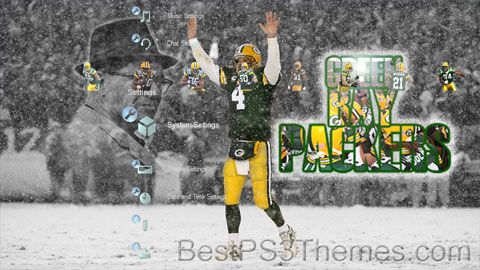
(1 background)
Green Bay Packers  Current season
Current seasonEstablished August 11, 1919[1]
First season: 1919
Play in and headquartered at Lambeau Field
Green Bay, Wisconsin
Green Bay Packers logo 
Green Bay Packers wordmark Logo Wordmark League/conference affiliations Independent (1919–1920)
National Football League (1921–present)- Western Division (1933–1949)
- National Conference (1950–1952)
- Western Conference (1953–1966)
- Central Division (1967–1969)
- National Football Conference (1970–present)
- Central Division (1970–2001)
- North Division (2002–present)
Current uniformTeam colors Dark green, gold, white[2][3]
Fight song "Go! You Packers Go!" Website packers.com Personnel Owner(s) Green Bay Packers, Inc. (537,460 stockholders – governed by a Board of Directors)[4][5] Chairman Mark Murphy CEO Mark Murphy President Mark Murphy General manager Brian Gutekunst Head coach Matt LaFleur Team history - Green Bay Packers (1919–present)
Team nicknames Championships League championships (13†[9][10])
Conference championships (9) Division championships (26) - NFL West: 1936, 1938, 1939, 1944, 1960, 1961, 1962, 1965
- NFL Central: 1966, 1967
- NFC Central: 1972, 1995, 1996, 1997
- NFC North: 2002, 2003, 2004, 2007, 2011, 2012, 2013, 2014, 2016, 2019, 2020, 2021
Playoff appearances (36) Home fields Team owner(s) - Green Bay Packers, Inc. (1923–present)
The Green Bay Packers are a professional American football team based in Green Bay, Wisconsin. Competing in the National Football League (NFL) as part of the National Football Conference (NFC) North division, the Packers are the third-oldest franchise in the NFL, established in 1919.[11][12] They are the only non-profit, community-owned major league professional sports team based in the United States.[a][13] Since 1957, home games have been played at Lambeau Field. They hold the record for the most wins in NFL history.[14][15]
The Packers are the last of the "small-town teams" that were common in the NFL during the league's early days of the 1920s and 1930s. Founded in 1919 by Earl "Curly" Lambeau and George Whitney Calhoun, the franchise traces its lineage to other semi-professional teams in Green Bay dating back to 1896. Between 1919 and 1920, the Packers competed against other semi-pro clubs from around Wisconsin and the Midwest, before joining the American Professional Football Association (APFA), the forerunner of today's NFL, in 1921. In 1933, the Packers began playing part of their home slate in Milwaukee until changes at Lambeau Field in 1995 made it more lucrative to stay in Green Bay full-time; Milwaukee is still considered a home media market for the team.[16][17][18] Although Green Bay is the smallest major league professional sports market in North America,[a][19] Forbes ranked the Packers as the world's 27th-most-valuable sports franchise in 2019, with a value of $2.63 billion.[20]
The Packers have won 13 league championships, the most in NFL history, with nine pre-Super Bowl NFL titles and four Super Bowl victories. The Packers, under coach Vince Lombardi, won the first two Super Bowls in 1966 and 1967; they were the only NFL team to defeat the American Football League (AFL) before the AFL–NFL merger. After Lombardi retired, the Super Bowl trophy was named for him, but the team struggled through the 1970s and 1980s. Since 1993, the team has enjoyed much regular-season success, making the playoffs 23 times and winning two Super Bowls in 1996 under head coach Mike Holmgren and 2010 under head coach Mike McCarthy.[21] The Packers have the most wins (826) and the second-highest win–loss record (.571) in NFL history, including both regular season and playoff games.[22][23] The Packers are longstanding adversaries of the Chicago Bears, Minnesota Vikings, and Detroit Lions, who today form the NFL's NFC North division (formerly known as the NFC Central Division). They have played more than 100 games against each of those teams, and have a winning overall record against all of them, a distinction only shared with the Kansas City Chiefs, Dallas Cowboys, and Miami Dolphins. The Bears–Packers rivalry is one of the oldest rivalries in U.S. professional sports history, dating to 1921.
Franchise history[edit]

Curly Lambeau, founder, player and first coach of the Packers Curly Lambeau years (1919–1949)[edit]
The Green Bay Packers were founded on August 11, 1919,[1] by former high-school football rivals Earl "Curly" Lambeau and George Whitney Calhoun.[24] Lambeau solicited funds for uniforms from his employer, the Indian Packing Company, a meat packing company.[25] He was given $500 ($8,800 today) for uniforms and equipment, on the condition that the team be named after its sponsor.[26] The Green Bay Packers have played in their original city longer than any other team in the NFL.
On August 27, 1921, the Packers were granted a franchise in the American Professional Football Association, a new national pro football league that had been formed the previous year. The APFA changed its name to the National Football League a year later. Financial troubles plagued the team, and the franchise was forfeited within the year before Lambeau found new financial backers and regained the franchise the next year. These backers, known as "The Hungry Five", formed the Green Bay Football Corporation.[27]
NFL champions (1929, 1930, 1931)[edit]
After a near-miss in 1927, Lambeau's squad claimed the Packers' first NFL title in 1929 with an undefeated 12–0–1 campaign, behind a stifling defense which registered eight shutouts.[28] Green Bay would repeat as league champions in 1930 and 1931, bettering teams from New York, Chicago and throughout the league, with all-time greats and future Hall of Famers Mike Michalske, Johnny (Blood) McNally, Cal Hubbard and Green Bay native Arnie Herber.[29][30] Among the many impressive accomplishments of these years was the Packers' streak of 29 consecutive home games without defeat, an NFL record which still stands.[31]
NFL champions (1936, 1939, 1944)[edit]

Don Hutson with the Packers; his jersey number was the first retired by the Packers (1951) The arrival of the end Don Hutson from Alabama in 1935 gave Lambeau and the Packers the most feared and dynamic offensive weapon in the game. Credited with inventing pass patterns, Hutson would lead the league in receptions in eight seasons and spur the Packers to NFL championships in 1936, 1939 and 1944. An Iron Man, Hutson played both ways, leading the league in interceptions as a safety in 1940. Hutson claimed 18 NFL records when he retired in 1945, many of which still stand.[32] In 1951, his number 14 was the first to be retired by the Packers, and he was inducted as a charter member of the Pro Football Hall of Fame in 1963.
After Hutson's retirement, Lambeau could not stop the Packers' slide. He purchased a large lodge near Green Bay for team members and families to live in. Rockwood Lodge was the home of the 1946–49 Packers. The 1947 and 1948 seasons produced a record of 12–10–1, and 1949 was even worse at 3–9. The lodge burned down on January 24, 1950, and insurance money paid for many of the Packers' debts.[33]

A 1950 depiction of Tony Canadeo, whose No. 3 was retired by the Packers in 1952 Curly Lambeau departed after the 1949 season. Gene Ronzani and Lisle Blackbourn could not coach the Packers back to their former magic, even as a new stadium was unveiled in 1957. The losing would descend to the disastrous 1958 campaign under coach Ray "Scooter" McLean, whose lone 1–10–1 year at the helm is the worst in Packers history.[34]
Vince Lombardi years (1959–1967)[edit]
Former New York Giants assistant Vince Lombardi was hired as Packers head coach and general manager on February 2, 1959. Few suspected the hiring represented the beginning of a remarkable, immediate turnaround. Under Lombardi, the Packers would become the team of the 1960s, winning five championships over seven years, including victories in the first two Super Bowls. During the Lombardi era, the stars of the Packers' offense included Bart Starr, Jim Taylor, Carroll Dale, Paul Hornung (as halfback and placekicker), Forrest Gregg, and Jerry Kramer. The defense included Willie Davis, Henry Jordan, Willie Wood, Ray Nitschke, Dave Robinson, and Herb Adderley.
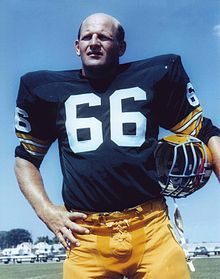
Ray Nitschke – his No. 66 jersey is one of six numbers retired by the Packers The Packers' first regular-season game under Lombardi was on September 27, 1959, a 9–6 victory over the Chicago Bears in Green Bay. After winning their first three, the Packers lost the next five before finishing strong by sweeping their final four. The 7–5 record represented the Packers' first winning season since 1947, enough to earn rookie head coach Lombardi the NFL Coach of the Year.
The next year, the Packers, led by Paul Hornung's 176 points, won the NFL West title and played in the NFL Championship against the Philadelphia Eagles at Philadelphia. In a see-saw game, the Packers trailed by only four points when All-Pro Eagle linebacker Chuck Bednarik tackled Jim Taylor just nine yards short of the goal line as time expired.
NFL champions (1961, 1962, 1965)[edit]

The "Golden Boy" Paul Hornung, featured on a 1961 sports card The Packers returned to the NFL Championship game the following season and faced the New York Giants in the first league title game to be played in Green Bay. The Packers scored 24-second-quarter points, including a championship-record 19 by Paul Hornung, on special "loan" from the Army (one touchdown, four extra points, and three field goals), powering the Packers to a 37–0 rout of the Giants, their first NFL Championship since 1944.[35] It was in 1961 that Green Bay became known as "Titletown".
The Packers stormed back in the 1962 season, jumping out to a 10–0 start on their way to a 13–1 season. This consistent level of success would lead to Lombardi's Packers becoming one of the most prominent teams of their era, and to be featured as the face of the NFL on the cover of Time on December 21, 1962, as part of the magazine's cover story on "The Sport of the '60s".[36] Shortly after Time's article, the Packers faced the Giants in a much more brutal championship game than the previous year, but the Packers prevailed on the kicking of Jerry Kramer and the determined running of Jim Taylor. The Packers defeated the Giants in New York, 16–7.
The Packers returned to the championship game in 1965 following a two-year absence when they defeated the Colts in a playoff for the Western Conference title. That game would be remembered for Don Chandler's controversial tying field goal in which the ball allegedly went wide right, but the officials signaled "good". The 13–10 overtime win earned the Packers a trip to the NFL Championship game, where Hornung and Taylor ran through the defending champion Cleveland Browns, helping the Packers win, 23–12, to earn their third NFL Championship under Lombardi and ninth overall. Goalpost uprights would be made taller the next year.
Super Bowl I champions (1966)[edit]

Packers Willie Davis (left) and Henry Jordan tackling a Chiefs player in the first AFL-NFL Championship (Super Bowl I) The 1966 season saw the Packers led to the first-ever Super Bowl by MVP quarterback Bart Starr. The team went 12–2, and as time wound down in the NFL Championship against the Dallas Cowboys, the Packers clung to a 34–27 lead. Dallas had the ball on the Packers' two-yard line, threatening to tie the ballgame. But on fourth down the Packers' Tom Brown intercepted Don Meredith's pass in the end zone to seal the win. The team crowned its season by rolling over the AFL champion Kansas City Chiefs 35–10 in Super Bowl I.
Super Bowl II champions (1967)[edit]
The 1967 season was the last for Lombardi as the Packers' head coach.[37] The NFL Championship game, a rematch of the 1966 contest against Dallas, became indelibly known as the "Ice Bowl" as a result of the brutally cold conditions at Lambeau Field.[38] Still the coldest NFL game ever played, it remains one of the most famous football games at any level in the history of the sport.[39] With 16 seconds left, Bart Starr's touchdown on a quarterback sneak brought the Packers a 21–17 victory and their still unequaled third straight NFL Championship. They then won Super Bowl II with a 33–14 victory over the Oakland Raiders. Lombardi stepped down as head coach after the game, and Phil Bengtson was named his suc
Toronto Maple Leafs
Toronto Maple Leafs theme by Raymond Regina
Download: TorontoMapleLeafs.p3t

(1 background)
Toronto Maple Leafs  2023–24 Toronto Maple Leafs season
2023–24 Toronto Maple Leafs season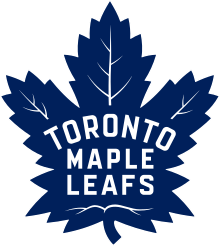
Conference Eastern Division Atlantic Founded 1917 History Toronto Arenas
1917–1919
Toronto St. Patricks
1919–1927
Toronto Maple Leafs
1927–presentHome arena Scotiabank Arena City Toronto, Ontario Team colours Blue, white[1][2]
Media Sportsnet Ontario
TSN4
Sportsnet 590 The Fan
TSN Radio 1050Owner(s) Maple Leaf Sports & Entertainment Ltd.
(Larry Tanenbaum, chairman)General manager Brad Treliving Head coach Craig Berube Captain John Tavares Minor league affiliates Toronto Marlies (AHL) Stanley Cups 13 (1917–18, 1921–22, 1931–32, 1941–42, 1944–45, 1946–47, 1947–48, 1948–49, 1950–51, 1961–62, 1962–63, 1963–64, 1966–67) Conference championships 0 Presidents' Trophy 0[note 1] Division championships 6 (1932–33, 1933–34, 1934–35, 1937–38, 1999–2000, 2020–21) Official website www .nhl .com /mapleleafs The Toronto Maple Leafs (officially the Toronto Maple Leaf Hockey Club and often referred to as the Leafs) are a professional ice hockey team based in Toronto. The Maple Leafs compete in the National Hockey League (NHL) as a member of the Atlantic Division in the Eastern Conference. The club is owned by Maple Leaf Sports & Entertainment, a company that owns several professional sports teams in the city. The Maple Leafs' broadcasting rights are split between BCE Inc. and Rogers Communications. For the first 14 seasons, the team played its home games at the Mutual Street Arena, before moving to Maple Leaf Gardens in 1931. The Maple Leafs moved to their present home, Scotiabank Arena (originally named Air Canada Centre), in February 1999.
The club was founded in 1917, operating simply as Toronto and known then as the Toronto Arenas. Under new ownership, the team was renamed the Toronto St. Patricks in 1919. In 1927, the franchise was purchased by Conn Smythe and renamed the Maple Leafs. A member of the "Original Six", the club was one of six NHL teams to have endured the period of League retrenchment during the Great Depression. The club has won 13 Stanley Cup championships, second only to the 24 championships of the Montreal Canadiens. The Maple Leafs history includes two recognized dynasties,[broken anchor] from 1947 to 1951; and from 1962 to 1967.[3][4] Winning their last championship in the 1966–67 season, the Maple Leafs' 57-season drought between championships is the longest drought in league history. The Maple Leafs have developed rivalries with five NHL franchises: the Boston Bruins, Buffalo Sabres, Detroit Red Wings, the Montreal Canadiens, and the Ottawa Senators.
The Maple Leafs have retired the use of 13 numbers in honour of 19 players, including the first in professional sports. In addition, several individuals who hold an association with the club have been inducted into the Hockey Hall of Fame. The Maple Leafs are presently affiliated with the Toronto Marlies of the American Hockey League (AHL).
Team history[edit]
Evolution of the Toronto Maple Leafs Teams Toronto Pro HC (ind., OPHL) 1906–1909 Toronto Blueshirts (NHA) 1912–1917 Toronto Arenas (NHL) 1917–1919 Toronto St. Patricks (NHL) 1919–1927 Toronto Maple Leafs (NHL) 1927–present Ice hockey portal Early years (1917–1927)[edit]
The National Hockey League was formed in 1917 in Montreal by teams formerly belonging to the National Hockey Association (NHA) that had a dispute with Eddie Livingstone, owner of the Toronto Blueshirts. The owners of the other four clubs—the Montreal Canadiens, Montreal Wanderers, Quebec Bulldogs and the Ottawa Senators—wanted to replace Livingstone, but discovered that the NHA constitution did not allow them to simply vote him out of the league.[5] Instead, they opted to create a new league, the NHL, and did not invite Livingstone to join them. They also remained voting members of the NHA, and thus had enough votes to suspend the other league's operations, effectively leaving Livingstone's league with one team.[6]
The NHL had decided that it would operate a four-team circuit, made up of the Canadiens, Montreal Maroons, Ottawa, and one more club in either Quebec City or Toronto. Toronto's inclusion in the NHL's inaugural season was formally announced on November 26, 1917, with concerns over the Bulldogs' financial stability surfacing.[7] The League granted temporary franchise rights to the Arena Company, owners of the Arena Gardens.[8] The NHL granted the Arena responsibility of the Toronto franchise for only the inaugural season, with specific instructions to resolve the dispute with Livingstone or transfer ownership of the Toronto franchise back to the League at the end of the season.[9]

Team photo of the Arenas from the 1917–18 season. The club won its first Stanley Cup in their inaugural season. The franchise did not have an official name but was informally called "the Blueshirts" or "the Torontos" by the fans and press.[10] Although the inaugural roster was made up of players leased from the NHA's Toronto Blueshirts, including Harry Cameron and Reg Noble, the Maple Leafs do not claim the Blueshirts' history as their own.[11] During the inaugural season, the club performed the first trade in NHL history, sending Sammy Hebert to the Senators, in return for cash.[12] Under manager Charlie Querrie, and head coach Dick Carroll, the team won the Stanley Cup in the inaugural 1917–18 season.[13]
For the next season, rather than return the Blueshirts' players to Livingstone as originally promised, on October 19, 1918, the Arena Company formed the Toronto Arena Hockey Club, which was readily granted full membership in the NHL.[14] The Arena Company also decided that year that only NHL teams were allowed to play at the Arena Gardens—a move which effectively killed the NHA.[15] Livingstone sued to get his players back. Mounting legal bills from the dispute forced the Arenas to sell some of their stars, resulting in a horrendous five-win season in 1918–19. With the company facing increasing financial difficulties, and the Arenas officially eliminated from the playoffs, the NHL agreed to let the team forfeit their last two games.[12][16] Operations halted on February 20, 1919, with the NHL ending its season and starting the playoffs. The Arenas' .278 winning percentage that season remains the worst in franchise history. However, the 1919 Stanley Cup Finals ended without a winner due to the worldwide flu epidemic.[12]

Team photo of the club during the 1921–22 season. Then known as the St. Patricks, the club won its second Stanley Cup in 1922. The legal dispute forced the Arena Company into bankruptcy, and it was forced to sell the team. On December 9, 1919, Querrie brokered the team's purchase by the owners of the St. Patricks Hockey Club (Percy and Fred Hambly),[17] allowing him to maintain an ownership stake in the team.[18] The new owners renamed the team the Toronto St. Patricks (or St. Pats for short), which they used until 1927.[19] Changing the colours of the team from blue to green, the club won their second Stanley Cup championship in 1922.[16] Babe Dye scored four times in the 5–1 Stanley Cup-clinching victory against the Vancouver Millionaires.[20]
In 1924, the team's ownership changed again, as movie theatre impresario Nathan Nathanson and mining magnate Jack Bickell purchased the shares of the Hamblys.[17] Bickell invested CA$25,000 in the St. Pats as a favour to his friend Querrie, who needed to financially reorganize his hockey team.[21]
Conn Smythe era (1927–1961)[edit]
After several financially difficult seasons, the St. Patricks' ownership group (Querrie and Nathan Nathanson)[22] seriously considered selling the team to C. C. Pyle for CA$200,000 (equivalent to $3,452,747 in 2023). Pyle sought to move the team to Philadelphia.[16][23] However, Toronto Varsity Blues coach Conn Smythe put together a group of his own and made a $160,000 CA$160,000 (equivalent to $2,762,198 in 2023)) offer. With the support of minority shareholder Bickell, Smythe persuaded Querrie and Nathanson to accept their bid, arguing that civic pride was more important than money.[23] Bickell would become team president.[24]
Smythe took control on February 14, 1927; installing himself as governor and general manager. He immediately renamed the team the Maple Leafs, after the national symbol of Canada.[25] He attributed his choice of a maple leaf for the logo to his experiences as a Canadian Army officer and prisoner of war during World War I. Viewing the maple leaf as a "badge of courage", and a reminder of home, Smythe decided to give the same name to his hockey team, in honour of the many Canadian soldiers who wore it.[16][26][27] However, the team was not the first to use the name. A Toronto minor-league baseball team had used the name "Toronto Maple Leafs" since 1895.[28] Although Smythe would not acquire controlling interest in the team until 1947, he would be the franchise's dominant voice for the next four decades.[29][30][31]
Initial reports were that the team's colours were to be red and white,[32] but the Leafs wore white sweaters with a green maple leaf for their first game on February 17, 1927.[33] On September 27, 1927, it was announced that the Leafs had changed their colour scheme to blue and white.[34] Although Smythe later stated he chose blue because it represents the Canadian skies and white to represent snow, these colours were also used on the trucks for his gravel and sand business.[34] The colour blue was also a colour historically associated with the City of Toronto. The use of blue by top-level Toronto-based sports clubs began with the Argonaut Rowing Club in the 19th century, later adopted by their football team, the Toronto Argonauts, in 1873.[35]
Opening of Maple Leaf Gardens (1930s)[edit]
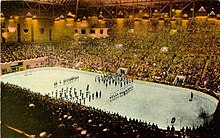
Opening ceremony for the first game at Maple Leaf Gardens on November 11, 1931 By 1930, Smythe saw the need to construct a new arena, viewing the Arena Gardens as a facility lacking modern amenities and seating.[36] Finding an adequate number of financiers, he purchased land from the Eaton family, and construction of the arena was completed in five months.[37][38]
The Maple Leafs debuted at their new arena, Maple Leaf Gardens, with a 2–1 loss to the Chicago Black Hawks on November 12, 1931.[38] The opening ceremonies for Maple Leaf Gardens included a performance from the 48th Highlanders of Canada Pipe and Drums.[39] The military band has continued to perform in every subsequent season home opening game, as well as other ceremonies conducted by the hockey club.[40][41] The debut also featured Foster Hewitt in his newly constructed press box above the ice surface, where he began his famous Hockey Night in Canada radio broadcasts that eventually came to be a Saturday-night tradition.[38] The press box was often called "the gondola", a name that emerged during the Gardens' inaugural season when a General Motors advertising executive remarked how it resembled the gondola of an airship.[42]
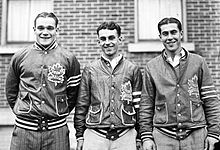
The Kid Line consisted of Charlie Conacher, Joe Primeau, and Busher Jackson (left to right). They led the Leafs to win the 1932 Stanley Cup, as well as four more Stanley Cup finals appearances over the next six years. By the 1931–32 NHL season, the Maple Leafs were led by the "Kid Line" consisting of Busher Jackson, Joe Primeau and Charlie Conacher and coached by Dick Irvin. The team captured their third Stanley Cup that season, vanquishing the Chicago Black Hawks in the first round, the Montreal Maroons in the semifinals, and the New York Rangers in the finals.[43] Smythe took particular pleasure in defeating the Rangers that year. He had been tapped as the Rangers' first general manager and coach for their inaugural season (1926–27) but had been fired in a dispute with Madison Square Garden management before the season had begun.[44]
Maple Leafs star forward Ace Bailey was nearly killed in 1933 when Boston Bruins defenceman Eddie Shore checked him from behind at full speed into the boards.[45] Leafs defenceman Red Horner knocked Shore out with a punch, but Bailey, writhing on the ice, had his career ended.[38] The Leafs held the Ace Bailey Benefit Game, the NHL's first All-Star Game, to collect medical funds to help Bailey. His jersey was retired later the same night.[46] The Leafs reached the finals five times in the next seven years but bowed out to the now-disbanded Maroons in 1935, the Detroit Red Wings in 1936, Chicago in 1938, Boston in 1939 and the Rangers in 1940.[38] After the end of the 1939–40 season, Smythe allowed Irvin to leave the team as head coach, replacing him with former Leafs captain Hap Day.[38]
The first dynasty (1940s)[edit]
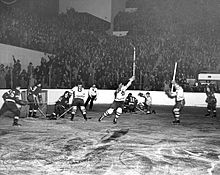
The Maple Leafs score against Detroit during the 1942 Cup Finals. The Leafs went on to win the series, performing the only reverse-sweep in the Finals. In the 1942 Stanley Cup Finals, the Maple Leafs were down three games to none in the best-of-seven series against Detroit. Fourth-line forward Don Metz then galvanized the team, to score a hat-trick in game four and the game-winner in game five.[47] Goalie Turk Broda shut out the Wings in game six, and Sweeney Schriner scored two goals in the third period to win the seventh game 3–1, completing the reverse-sweep.[48] The Leafs remain the only team to have successfully performed a reverse-sweep in the Stanley Cup finals.[49] Captain Syl Apps won the Lady Byng Memorial Trophy that season, not taking one penalty, and finished his ten-season career with an average of 5 minutes, 36 seconds in penalties a season.[50]
Smythe, who reenlisted in the Canadian Army at the outbreak of World War II, was given leave from military duty to view the final game of the 1942 finals. He arrived at the game in full military regalia.[48] Earlier, at the outbreak of war, Smythe arranged for many of his Maple Leafs players and staff to take army training with the Toronto Scottish Regiment. Most notably, the Leafs announced a large portion of their roster had enlisted, including Apps, and Broda,[51] who did not play on the team for several seasons due to their obligations with the Canadian Forces.[52] During this period, the Leafs turned to lesser-known players such as rookie goaltender Frank McCool and defenceman Babe Pratt.[52][53]
The Maple Leafs beat the Red Wings in the 1945 Finals. They won the first three games, with goaltender McCool recording consecutive shutouts. However, in a reversal of the 1942 finals, the Red Wings won the next three games.[52] The Leafs were able to win the series, winning the seventh game by the score of 2–1 to prevent a complete reversal of the series played three years ago.[52]
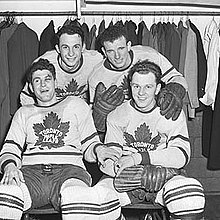
Maple Leafs players during the 1946–47 season. The team would win its sixth Stanley Cup that season. After the end of the war, players who had enlisted were beginning to return to their teams.[52] With Apps and Broda regaining their form, the Maple Leafs beat the first-place Canadiens in the
Coventry Bees Speedway
Coventry Bees Speedway theme by kornyme
Download: CoventryBeesSpeedway.p3t

(7 backgrounds)
P3T Unpacker v0.12
Copyright (c) 2007. Anoop MenonThis program unpacks Playstation 3 Theme files (.p3t) so that you can touch-up an existing theme to your likings or use a certain wallpaper from it (as many themes have multiple). But remember, if you use content from another theme and release it, be sure to give credit!
Download for Windows: p3textractor.zip
Instructions:
Download p3textractor.zip from above. Extract the files to a folder with a program such as WinZip or WinRAR. Now there are multiple ways to extract the theme.
The first way is to simply open the p3t file with p3textractor.exe. If you don’t know how to do this, right click the p3t file and select Open With. Alternatively, open the p3t file and it will ask you to select a program to open with. Click Browse and find p3textractor.exe from where you previously extracted it to. It will open CMD and extract the theme to extracted.[filename]. After that, all you need to do for any future p3t files is open them and it will extract.
The second way is very simple. Just drag the p3t file to p3textractor.exe. It will open CMD and extract the theme to extracted.[filename].
For the third way, first put the p3t file you want to extract into the same folder as p3textractor.exe. Open CMD and browse to the folder with p3extractor.exe. Enter the following:
p3textractor filename.p3t [destination path]Replace filename with the name of the p3t file, and replace [destination path] with the name of the folder you want the files to be extracted to. A destination path is not required. By default it will extract to extracted.filename.Liverpool FC Torres
Liverpool FC Torres theme by Chris Jones
Download: LiverpoolFCTorres.p3t
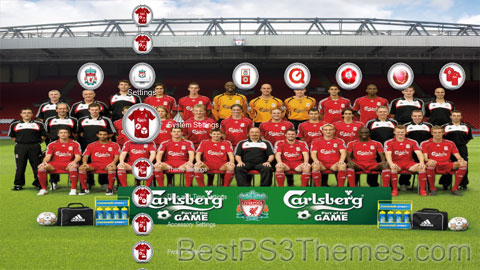
(3 backgrounds)
P3T Unpacker v0.12
Copyright (c) 2007. Anoop MenonThis program unpacks Playstation 3 Theme files (.p3t) so that you can touch-up an existing theme to your likings or use a certain wallpaper from it (as many themes have multiple). But remember, if you use content from another theme and release it, be sure to give credit!
Download for Windows: p3textractor.zip
Instructions:
Download p3textractor.zip from above. Extract the files to a folder with a program such as WinZip or WinRAR. Now there are multiple ways to extract the theme.
The first way is to simply open the p3t file with p3textractor.exe. If you don’t know how to do this, right click the p3t file and select Open With. Alternatively, open the p3t file and it will ask you to select a program to open with. Click Browse and find p3textractor.exe from where you previously extracted it to. It will open CMD and extract the theme to extracted.[filename]. After that, all you need to do for any future p3t files is open them and it will extract.
The second way is very simple. Just drag the p3t file to p3textractor.exe. It will open CMD and extract the theme to extracted.[filename].
For the third way, first put the p3t file you want to extract into the same folder as p3textractor.exe. Open CMD and browse to the folder with p3extractor.exe. Enter the following:
p3textractor filename.p3t [destination path]Replace filename with the name of the p3t file, and replace [destination path] with the name of the folder you want the files to be extracted to. A destination path is not required. By default it will extract to extracted.filename.

